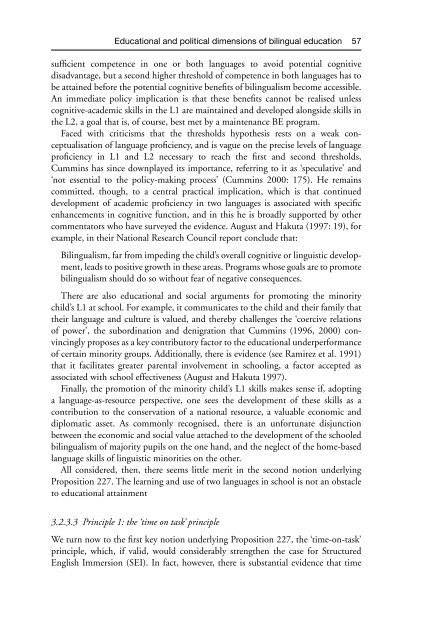Gibson Ferguson Language Planning and Education Edinburgh ...
Gibson Ferguson Language Planning and Education Edinburgh ...
Gibson Ferguson Language Planning and Education Edinburgh ...
Create successful ePaper yourself
Turn your PDF publications into a flip-book with our unique Google optimized e-Paper software.
<strong>Education</strong>al <strong>and</strong> political dimensions of bilingual education 57<br />
sufficient competence in one or both languages to avoid potential cognitive<br />
disadvantage, but a second higher threshold of competence in both languages has to<br />
be attained before the potential cognitive benefits of bilingualism become accessible.<br />
An immediate policy implication is that these benefits cannot be realised unless<br />
cognitive-academic skills in the L1 are maintained <strong>and</strong> developed alongside skills in<br />
the L2, a goal that is, of course, best met by a maintenance BE program.<br />
Faced with criticisms that the thresholds hypothesis rests on a weak conceptualisation<br />
of language proficiency, <strong>and</strong> is vague on the precise levels of language<br />
proficiency in L1 <strong>and</strong> L2 necessary to reach the first <strong>and</strong> second thresholds,<br />
Cummins has since downplayed its importance, referring to it as ‘speculative’ <strong>and</strong><br />
‘not essential to the policy-making process’ (Cummins 2000: 175). He remains<br />
committed, though, to a central practical implication, which is that continued<br />
development of academic proficiency in two languages is associated with specific<br />
enhancements in cognitive function, <strong>and</strong> in this he is broadly supported by other<br />
commentators who have surveyed the evidence. August <strong>and</strong> Hakuta (1997: 19), for<br />
example, in their National Research Council report conclude that:<br />
Bilingualism, far from impeding the child’s overall cognitive or linguistic development,<br />
leads to positive growth in these areas. Programs whose goals are to promote<br />
bilingualism should do so without fear of negative consequences.<br />
There are also educational <strong>and</strong> social arguments for promoting the minority<br />
child’s L1 at school. For example, it communicates to the child <strong>and</strong> their family that<br />
their language <strong>and</strong> culture is valued, <strong>and</strong> thereby challenges the ‘coercive relations<br />
of power’, the subordination <strong>and</strong> denigration that Cummins (1996, 2000) convincingly<br />
proposes as a key contributory factor to the educational underperformance<br />
of certain minority groups. Additionally, there is evidence (see Ramirez et al. 1991)<br />
that it facilitates greater parental involvement in schooling, a factor accepted as<br />
associated with school effectiveness (August <strong>and</strong> Hakuta 1997).<br />
Finally, the promotion of the minority child’s L1 skills makes sense if, adopting<br />
a language-as-resource perspective, one sees the development of these skills as a<br />
contribution to the conservation of a national resource, a valuable economic <strong>and</strong><br />
diplomatic asset. As commonly recognised, there is an unfortunate disjunction<br />
between the economic <strong>and</strong> social value attached to the development of the schooled<br />
bilingualism of majority pupils on the one h<strong>and</strong>, <strong>and</strong> the neglect of the home-based<br />
language skills of linguistic minorities on the other.<br />
All considered, then, there seems little merit in the second notion underlying<br />
Proposition 227. The learning <strong>and</strong> use of two languages in school is not an obstacle<br />
to educational attainment<br />
3.2.3.3 Principle 1: the ‘time on task’ principle<br />
We turn now to the first key notion underlying Proposition 227, the ‘time-on-task’<br />
principle, which, if valid, would considerably strengthen the case for Structured<br />
English Immersion (SEI). In fact, however, there is substantial evidence that time






